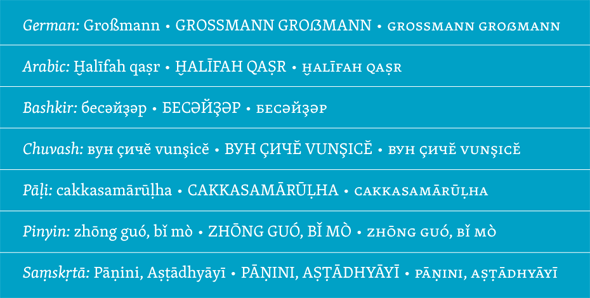Skolar fonts in our library have been updated to the most recent version (2.5). This version includes extended language support and kerning, and in the PE version a vast amount of Latin transliteration support.
This is a free update for all customers who bought Skolar from Rosetta. Please, send us an email if you are interested.

Details
Skolar Latin Pro and Skolar PE now include the capital form of German ß. The small-cap version is also included.
Skolar Cyrillic and Skolar PE now also supports Bashkir, Chuvash, Ossetic, and Komi. That makes for more than 41 languages altogether.
Skolar PE now has better and more consistent linguistic extension. It supports more than 30 languages via various standardised Latin transliterations (aka romanizations). Namely Arabic, Chinese (Pinyin), contemporary Indian languages, Pali, and Sanskrit are supported in all weights and italics in lowercase, uppercase, even in small caps! See the complete list below. Some of these transliterations make use of the automatic accent/mark positioning (in PE version only) so users can key base characters followed by the combining marks, and the font will combine them properly (see the bottom of page 10 of the PDF specimen for examples). Please note that this OpenType® feature is supported in InDesign CS3 and higher, Flash Player 10, MS Word 2012, Mellel 2.2–2.7, and XeTeX.
All Skolar fonts now include improved kerning, particularly kerning of punctuation (period, apostrophe, …). Note that for this reason the text originally set in some older version can reflow when reset in the updated version. Therefore, we recommend keeping backup copies of the old versions.
Note: All Rosetta fonts supporting Latin standard character set now officially support over 90 languages. Frankly, this is not due to the increased number of glyphs, but thanks to better language research conducted recently in order to provide precise information about our fonts. Similarly, fonts with extended Cyrillic support (that is Neacademia and Skolar) now support more than 41 languages (Neacademia 44 in fact). See the backs of the PDF specimens for precise listings.
Skolar now supports over 162 languages (90 in Latin, 41 in Cyrillic, Greek, and ca. 30 via transliterations) and includes more than 2600 glyphs in each weight.
Transliterations supported in Skolar PE
Arabic (DMG, ISO 233, ISO/R 233, UN, EI), Amharic, Burmese, Greek, Chinese (Pinyin), Contemporary Indian languages (Hunterian transliteration, National Library at Kolkata, UN), Japanese (Modified Hepburn, Kunrei), Kazakh, Khmer, Korean (McCune Reischauer, National standard), Kyrgyz, Laotian, Macedonian, Mongolian, Nepali, Pali (Rhys Davids system), Russian, Sanskrit (IAST), Tajik, Ukrainian, Urdu, Uzbek, …
Unless stated otherwise, the transliterations are based on UN and/or nationally approved systems.